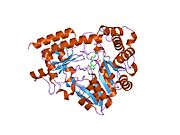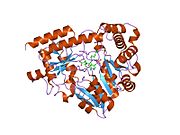KYAT1
| KYAT1 | |||||||||||||||||||||||||||||||||||||||||||||||||||
|---|---|---|---|---|---|---|---|---|---|---|---|---|---|---|---|---|---|---|---|---|---|---|---|---|---|---|---|---|---|---|---|---|---|---|---|---|---|---|---|---|---|---|---|---|---|---|---|---|---|---|---|
 | |||||||||||||||||||||||||||||||||||||||||||||||||||
| |||||||||||||||||||||||||||||||||||||||||||||||||||
| Identifiers | |||||||||||||||||||||||||||||||||||||||||||||||||||
| Aliases | KYAT1, GTK, KAT1, KATI, CCBL1, kynurenine aminotransferase 1 | ||||||||||||||||||||||||||||||||||||||||||||||||||
| External IDs | OMIM: 600547; MGI: 1917516; HomoloGene: 37872; GeneCards: KYAT1; OMA:KYAT1 - orthologs | ||||||||||||||||||||||||||||||||||||||||||||||||||
| EC number | 4.4.1.13 | ||||||||||||||||||||||||||||||||||||||||||||||||||
| |||||||||||||||||||||||||||||||||||||||||||||||||||
| |||||||||||||||||||||||||||||||||||||||||||||||||||
| |||||||||||||||||||||||||||||||||||||||||||||||||||
| |||||||||||||||||||||||||||||||||||||||||||||||||||
| Wikidata | |||||||||||||||||||||||||||||||||||||||||||||||||||
| |||||||||||||||||||||||||||||||||||||||||||||||||||
Kynurenine—oxoglutarate transaminase 1 is an enzyme that in humans is encoded by the CCBL1 gene.[4][5] It is one of the Kynurenine—oxoglutarate transaminases.
This gene encodes a cytosolic enzyme which is responsible for the metabolism of cysteine conjugates of certain halogenated alkenes and alkanes. This metabolism leads to the formation of reactive metabolites which can lead to nephrotoxicity and neurotoxicity.[5]
References
- ^ a b c GRCm38: Ensembl release 89: ENSMUSG00000039648 – Ensembl, May 2017
- ^ "Human PubMed Reference:". National Center for Biotechnology Information, U.S. National Library of Medicine.
- ^ "Mouse PubMed Reference:". National Center for Biotechnology Information, U.S. National Library of Medicine.
- ^ Perry S, Harries H, Scholfield C, Lock T, King L, Gibson G, Goldfarb P (Apr 1995). "Molecular cloning and expression of a cDNA for human kidney cysteine conjugate beta-lyase". FEBS Lett. 360 (3): 277–80. doi:10.1016/0014-5793(95)00123-Q. PMID 7883047. S2CID 83606450.
- ^ a b "Entrez Gene: CCBL1 cysteine conjugate-beta lyase; cytoplasmic (glutamine transaminase K, kyneurenine aminotransferase)".
External links
- Human CCBL1 genome location and CCBL1 gene details page in the UCSC Genome Browser.
Further reading
- Cooper AJ (2004). "The role of glutamine transaminase K (GTK) in sulfur and alpha-keto acid metabolism in the brain, and in the possible bioactivation of neurotoxicants". Neurochem. Int. 44 (8): 557–77. doi:10.1016/j.neuint.2003.12.002. PMID 15016471. S2CID 7643547.
- Lash LH, Nelson RM, Van Dyke RA, Anders MW (1990). "Purification and characterization of human kidney cytosolic cysteine conjugate beta-lyase activity". Drug Metab. Dispos. 18 (1): 50–4. PMID 2139845.
- Abraham DG, Patel PP, Cooper AJ (1995). "Isolation from rat kidney of a cytosolic high molecular weight cysteine-S-conjugate beta-lyase with activity toward leukotriene E4". J. Biol. Chem. 270 (1): 180–8. doi:10.1074/jbc.270.1.180. PMID 7814371.
- Goldfarb P, Perry S, Harries H, et al. (1996). "Molecular cloning and expression of cDNAs for rat and human kidney cysteine conjugate beta-lyase". Biochem. Soc. Trans. 24 (2): 330S. doi:10.1042/bst024330s. PMID 8736988.
- Iyer RA, Anders MW (1997). "Cysteine conjugate beta-lyase-dependent biotransformation of the cysteine S-conjugates of the sevoflurane degradation product compound A in human, nonhuman primate, and rat kidney cytosol and mitochondria". Anesthesiology. 85 (6): 1454–61. doi:10.1097/00000542-199612000-00028. PMID 8968194. S2CID 39394531.
- Gilley J, Fried M (1999). "Extensive gene order differences within regions of conserved synteny between the Fugu and human genomes: implications for chromosomal evolution and the cloning of disease genes". Hum. Mol. Genet. 8 (7): 1313–20. doi:10.1093/hmg/8.7.1313. PMID 10369878.
- Strausberg RL, Feingold EA, Grouse LH, et al. (2003). "Generation and initial analysis of more than 15,000 full-length human and mouse cDNA sequences". Proc. Natl. Acad. Sci. U.S.A. 99 (26): 16899–903. Bibcode:2002PNAS...9916899M. doi:10.1073/pnas.242603899. PMC 139241. PMID 12477932.
- Ota T, Suzuki Y, Nishikawa T, et al. (2004). "Complete sequencing and characterization of 21,243 full-length human cDNAs". Nat. Genet. 36 (1): 40–5. doi:10.1038/ng1285. PMID 14702039.
- Humphray SJ, Oliver K, Hunt AR, et al. (2004). "DNA sequence and analysis of human chromosome 9". Nature. 429 (6990): 369–74. Bibcode:2004Natur.429..369H. doi:10.1038/nature02465. PMC 2734081. PMID 15164053.
- Gerhard DS, Wagner L, Feingold EA, et al. (2004). "The Status, Quality, and Expansion of the NIH Full-Length cDNA Project: The Mammalian Gene Collection (MGC)". Genome Res. 14 (10B): 2121–7. doi:10.1101/gr.2596504. PMC 528928. PMID 15489334.
- Rual JF, Venkatesan K, Hao T, et al. (2005). "Towards a proteome-scale map of the human protein-protein interaction network". Nature. 437 (7062): 1173–8. Bibcode:2005Natur.437.1173R. doi:10.1038/nature04209. PMID 16189514. S2CID 4427026.
- Kimura K, Wakamatsu A, Suzuki Y, et al. (2006). "Diversification of transcriptional modulation: Large-scale identification and characterization of putative alternative promoters of human genes". Genome Res. 16 (1): 55–65. doi:10.1101/gr.4039406. PMC 1356129. PMID 16344560.
- Kapoor R, Lim KS, Cheng A, et al. (2006). "Preliminary evidence for a link between schizophrenia and NMDA-glycine site receptor ligand metabolic enzymes, d-amino acid oxidase (DAAO) and kynurenine aminotransferase-1 (KAT-1)". Brain Res. 1106 (1): 205–10. doi:10.1016/j.brainres.2006.05.082. PMID 16828464. S2CID 42325649.
- v
- t
- e
-
 1w7l: CRYSTAL STRUCTURE OF HUMAN KYNURENINE AMINOTRANSFERASE I
1w7l: CRYSTAL STRUCTURE OF HUMAN KYNURENINE AMINOTRANSFERASE I -
 1w7m: CRYSTAL STRUCTURE OF HUMAN KYNURENINE AMINOTRANSFERASE I IN COMPLEX WITH L-PHE
1w7m: CRYSTAL STRUCTURE OF HUMAN KYNURENINE AMINOTRANSFERASE I IN COMPLEX WITH L-PHE -
 1w7n: CRYSTAL STRUCTURE OF HUMAN KYNURENINE AMINOTRANSFERASE I IN PMP FORM
1w7n: CRYSTAL STRUCTURE OF HUMAN KYNURENINE AMINOTRANSFERASE I IN PMP FORM
 | This article on a gene on human chromosome 9 is a stub. You can help Wikipedia by expanding it. |
- v
- t
- e


















